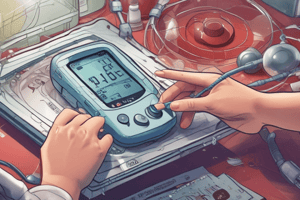Podcast
Questions and Answers
Which type of nutrition is typically preferred for providing adequate caloric and nutrient intake to prevent adverse consequences of malnutrition in hospitalized patients?
Which type of nutrition is typically preferred for providing adequate caloric and nutrient intake to prevent adverse consequences of malnutrition in hospitalized patients?
- Intravenous nutrition
- Oral nutrition
- Enteral nutrition (correct)
- Parenteral nutrition
What are some factors that can contribute to decreased voluntary intake of food in hospitalized patients?
What are some factors that can contribute to decreased voluntary intake of food in hospitalized patients?
- Limited food options
- Excessive food intake
- Nausea, pain, and anxiety (correct)
- Increased appetite and comfort
True or False: Endocrine changes resulting in a catabolic state have been proven to be a significant cause of malnutrition in hospitalized patients.
True or False: Endocrine changes resulting in a catabolic state have been proven to be a significant cause of malnutrition in hospitalized patients.
- False (correct)
- True
Severe protein catabolism can have adverse effects on which of the following in hospitalized patients?
Severe protein catabolism can have adverse effects on which of the following in hospitalized patients?
Malnutrition in humans can lead to increased complication rates, longer duration of hospitalization, and higher costs.
Malnutrition in humans can lead to increased complication rates, longer duration of hospitalization, and higher costs.
In terms of nutritional status, how should each patient be categorized?
In terms of nutritional status, how should each patient be categorized?
What is an important aspect to consider when assessing a patient's nutritional status?
What is an important aspect to consider when assessing a patient's nutritional status?
Which type of nutrition is typically easier to assess in dogs compared to horses?
Which type of nutrition is typically easier to assess in dogs compared to horses?
What is the main goal of enteral nutrition in hospitalized patients?
What is the main goal of enteral nutrition in hospitalized patients?
What can malnutrition in hospitalized patients lead to in terms of gastrointestinal health?
What can malnutrition in hospitalized patients lead to in terms of gastrointestinal health?
Which of the following conditions is NOT a risk factor for protein calorie malnutrition in critically ill patients?
Which of the following conditions is NOT a risk factor for protein calorie malnutrition in critically ill patients?
What is the formula for calculating Resting Energy Requirements (RER) in animals?
What is the formula for calculating Resting Energy Requirements (RER) in animals?
Which of the following conditions may require more than RER for nutritional needs?
Which of the following conditions may require more than RER for nutritional needs?
What is the recommended starting point for feeding patients with prolonged anorexia, marked GI compromise, or metabolic derangements?
What is the recommended starting point for feeding patients with prolonged anorexia, marked GI compromise, or metabolic derangements?
Which of the following factors is NOT considered when deciding the route of nutritional delivery?
Which of the following factors is NOT considered when deciding the route of nutritional delivery?
Which of the following conditions is NOT included in the list of high risk patients requiring aggressive nutritional plans?
Which of the following conditions is NOT included in the list of high risk patients requiring aggressive nutritional plans?
What is the purpose of re-evaluating and re-assessing the nutritional plan in high risk patients?
What is the purpose of re-evaluating and re-assessing the nutritional plan in high risk patients?
Which of the following is NOT a condition that may lead to dramatic loss in lean muscle mass in critically ill patients?
Which of the following is NOT a condition that may lead to dramatic loss in lean muscle mass in critically ill patients?
Which of the following is NOT a factor that may affect the nutritional plan in high risk patients?
Which of the following is NOT a factor that may affect the nutritional plan in high risk patients?
What is the recommended frequency for re-assessing the nutritional needs of patients?
What is the recommended frequency for re-assessing the nutritional needs of patients?




